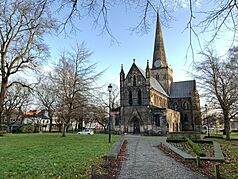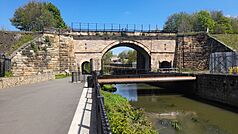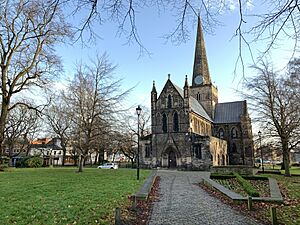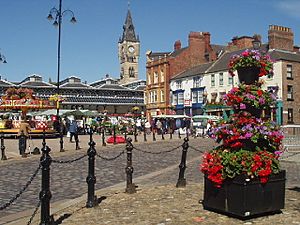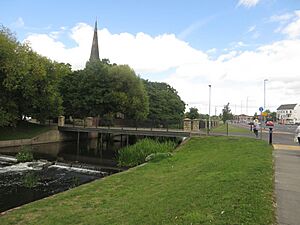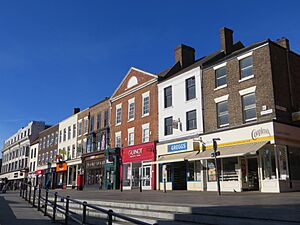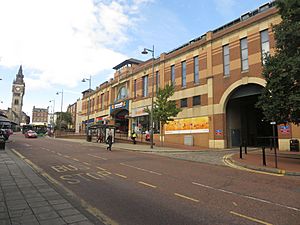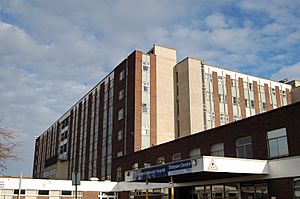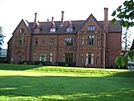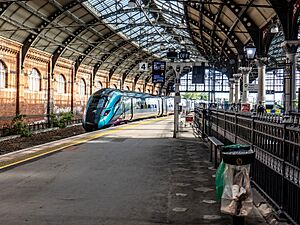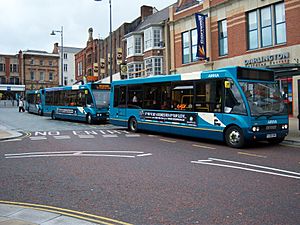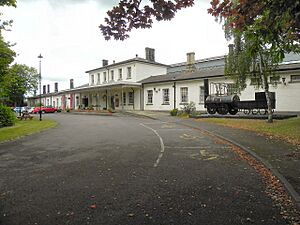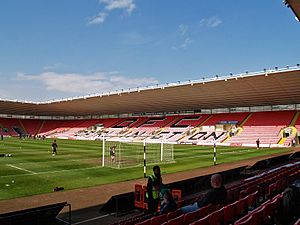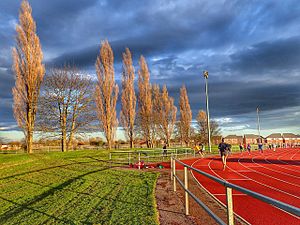Darlington facts for kids
Quick facts for kids Darlington |
|
|---|---|
| Town | |
|
Blackwellgate, Post House Wynd, the Market Hall, St Cuthbert's Church and Skerne Bridge |
|
| Area | 19.73 km2 (7.62 sq mi) |
| Population | 107,800 |
| • Density | 4,680.81/km2 (12,123.2/sq mi) (Town) |
| OS grid reference | NZ289147 |
| • London | 219 mi (352 km) south |
| Unitary authority |
|
| Ceremonial county | |
| Region | |
| Country | England |
| Sovereign state | United Kingdom |
| Post town | DARLINGTON |
| Postcode district | DL1, DL2, DL3 |
| Dialling code | 01325 |
| Police | Durham |
| Fire | County Durham and Darlington |
| Ambulance | North East |
| EU Parliament | North East England |
| UK Parliament |
|
Darlington is a busy town in County Durham, England. It is known for its history as a market town and its important role in the Industrial Revolution. Darlington is the main centre for the Borough of Darlington, which is part of the Tees Valley area.
The River Skerne, a smaller river that flows into the River Tees, runs through the town. Darlington is also close to the beautiful Yorkshire Dales National Park, about 11 miles (18 km) away. In 2021, about 107,800 people lived in Darlington, making it a "large town".
In the 1800s, Darlington became very important because of the Stockton and Darlington Railway. This was the world's first permanent railway to use steam locomotives for passengers. This railway helped the town grow into a major industrial and manufacturing hub.
Contents
History of Darlington
Early Days
Darlington began as a settlement built by the Anglo-Saxons. Its name, Dearthington, likely meant 'the home of Deornoth's people'. By the time the Normans arrived, it was called Derlinton. For a while in the 1600s and 1700s, people often called the town Darnton.
The town centre has a historic market area. St Cuthbert's Church, built in 1183, is a very old and important church in northern England. It is a Grade I listed building, meaning it's historically significant. The oldest church in Darlington is St Andrew's Church, built around 1100 in Haughton-le-Skerne.
In the 1700s, a writer named Daniel Defoe visited Darlington. He noted that the town was good at "bleaching linen," which means making cloth white. However, he also said the town was "nothing remarkable but dirt," because roads were usually unpaved back then.
Victorian Era and Railways
In the early 1800s, Darlington was still a small market town. But everything changed with the Stockton and Darlington Railway. This railway used steam engines to carry both passengers and goods. On September 27, 1825, George Stephenson's famous engine, Locomotion No. 1, made its first journey. It travelled between Shildon and Stockton-on-Tees, passing through Darlington. This event marked the beginning of the modern railway age!
Later in the 1800s, Darlington became a major centre for building railway equipment. The Hopetown Carriage Works, started in 1853, made carriages and engines for the Stockton and Darlington Railway. Other companies, like William and Alfred Kitching, also built locomotives here. Eventually, Darlington had three big railway factories:
- The largest was the Darlington Works, which operated from 1863 to 1966.
- Robert Stephenson & Co. moved to Darlington in 1902 and closed by 1964.
- Faverdale Wagon Works, opened in 1923, was a pioneer in mass-producing railway wagons.
Quakers and Community
During the 1800s, important Quaker families, like the Pease and Backhouse families, became major employers and helped the town a lot. Joseph Pease, an industrialist, gave Darlington its famous clock tower in 1864. The bells in the tower are like the ones in Big Ben in London!
The Darlington Mechanics Institute opened in 1854, thanks to a donation from Elizabeth Pease Nichol. In 1853, South Park was created with money from the Backhouse family. It covers over 91 acres.
A famous architect named Alfred Waterhouse, who designed London's Natural History Museum, also designed Darlington's Old Town Hall and Market Hall, Darlington in 1860. He also designed the Backhouse's Bank building, which is now a Barclays bank.
The The Northern Echo newspaper started in 1870. Its most famous editor, William Thomas Stead, sadly died on the Titanic. There's a pub named after him in Darlington.
Modern Times
In 1939, Darlington had more cinema seats per person than any other place in the UK!
During World War II, on January 13, 1945, a Lancaster bomber crashed near Darlington. The pilot, William Stuart McMullen, bravely stayed with the plane to steer it away from houses, saving his crew and people on the ground. He died in the crash. A road was renamed "McMullen Road" and a memorial was built to honour his heroism.
In 1993, a group of railway fans started building a brand new steam locomotive called Tornado. It was the first one built since the 1960s. Many original engines of this type were built in Darlington. Tornado was finished in 2008.
To celebrate Darlington's railway history, artist David Mach created a sculpture called Train in 1997. It's a life-size brick sculpture of a steaming locomotive coming out of a tunnel. It's made from 185,000 bricks!
In 2001, Darlington was the first place in England to allow same-sex civil ceremonies. The town also hosts an annual Gay Pride Festival. In 2005, parts of the town centre were made into pedestrian-only areas.
How Darlington is Governed
Darlington is run by the Darlington Borough Council. This council is a unitary authority, meaning it handles most local government services for the town and nearby areas. The council works with other nearby towns as part of the Tees Valley Combined Authority. The council's main office is at Darlington Town Hall.
Historically, Darlington was divided into smaller areas called townships. Over time, these areas joined together, and Darlington became a municipal borough in 1867. In 1997, it became a unitary authority, giving it more control over its own services.
The person who represents Darlington in the UK Parliament is called the MP. As of 2024, the MP for the Darlington constituency is Lola McEvoy from the Labour party.
Geography of Darlington
Darlington is located in the southern part of County Durham. It is very close to the River Tees, which forms the border between Durham and Yorkshire. Both the River Tees and the River Skerne flow through the area. The Skerne eventually joins the Tees, which then flows into the North Sea.
Areas in the Borough
The borough of Darlington includes several smaller areas:
- To the north: Harrowgate, Coatham Mundeville and Beaumont Hill.
- To the north-east: Whinfield and Haughton Le Skerne.
- To the east: Eastbourne and Red Hall.
- To the south: Firthmoor and Skerne Park.
- To the west: Hummersknott, Mowden and Blackwell.
- To the north-west: Branksome, Cockerton, Faverdale, The Denes, West Park, High Grange and Pierremont.
How Far is it to Other Places?
| Place | Distance | Direction | Relation |
|---|---|---|---|
| Hartlepool | 18 miles (29 km) | North East | Part of the same Combined Authority area |
| Durham | 17 miles (27 km) | North | Historic county town and closest city |
| Middlesbrough | 13 miles (21 km) | East | Part of the same Combined Authority area |
| Stockton-on-Tees | 10 miles (16 km) | East | Part of the same Combined Authority area |
Darlington's Economy
Today, the main parts of Darlington's economy are finance (money services) and manufacturing (making things).
Service Sector
A big employer in Darlington is the English part of the Student Loans Company, called Student Finance England. It has over 1,000 employees. Other large companies with offices here include Darlington Building Society.
The Department for Education also has an office in Darlington. The Disclosure and Barring Service, which helps check people's backgrounds, has a national office in the town. Amazon UK opened a large warehouse in 2020, employing 1,300 full-time staff.
Telecommunications
EE, a big phone company, is the largest private employer in Darlington, with 2,500 staff.
Engineering
Darlington has a long history of engineering. Building Bridges was especially important. Bridges built in Darlington can be found spanning rivers like the River Nile and the Amazon!
Some local engineering companies include:
- Cummins: has an engine building factory near Morton Park.
- AMEC: its industrial part has its main office in the town.
- Whessoe: started in Darlington.
Shops and Fun
As an old market town, Darlington still has a weekly outdoor market in the market square. There's also an indoor market under the town clock.
You can find shops in places like:
- Prebend Row, home to the Cornmill Shopping Centre.
- Grange Road and Skinnergate, with many independent shops.
- Duke Street, which has art galleries and restaurants.
- Argos, a UK shop, has its biggest warehouse in the North of England in Darlington.
Hospitals
Darlington Memorial Hospital is the main hospital in town. There is also a private hospital called Woodlands Hospital at Morton Park.
Culture and Landmarks
Mowden Hall, Sockburn Hall, the Majestic Theatre (left of the photo) and the Hippodrome theatre
Theatre and Music
The former Civic Theatre, now called The Hippodrome, is a popular place for shows. It hosts musicals, plays, and pantomimes. In 2016, it closed for a big £12.3 million renovation and reopened as The Hippodrome. It also connects to a children's theatre called Hullabaloo.
The Forum Music Centre, opened in 2004, has regular live music events, from Ska to Indie rock. It also has a comedy club, a recording studio, and rehearsal rooms.
Churches and Mosque
Darlington has many churches, including the famous St Cuthbert's in the town centre. It has a tall spire and is a Grade I listed building. There are also Methodist, Baptist, Roman Catholic and Jehovah Witness places of worship.
The Jamia Mosque and Islamic Society of Darlington is located in the North Lodge Terrace area. It offers worship and Islamic education.
Transport in Darlington
Air Travel
Teesside International Airport is about 5 miles (8 km) east of Darlington. It has flights to some places in the UK and Europe. It's also used for many private flights.
The closest large airports are Newcastle (42 miles / 68 km away) and Leeds Bradford (62 miles / 100 km away).
Railway Travel
Darlington railway station is an important stop on the East Coast Main Line. You can catch trains here to many cities, including London, York, Newcastle, Edinburgh, Liverpool, and Birmingham.
Local trains also run on the Tees Valley Line, connecting Darlington to towns like Bishop Auckland, Middlesbrough, and Saltburn. Services also stop at North Road, which was the town's original station. Darlington railway station has a large Victorian clock tower that you can see from many parts of the town.
Roads
Darlington is well connected to the A1(M) motorway, which goes around the west side of the town. This motorway was finished in 1965. The town has three exits from the A1(M). Other important roads include the A66, which connects Darlington to Stockton-on-Tees.
Buses
Most bus routes in Darlington are run by Arriva North East. Their buses connect Darlington to nearby towns and cities like Durham, Bishop Auckland, and Middlesbrough.
Cycling
Darlington has been chosen as a "Sustainable Travel Demonstration Town" and a "Cycling Demonstration Town" by the government. This means it received funding to encourage walking, cycling, and public transport. The town centre has been improved to make it easier for pedestrians and cyclists, and it's connected to the national cycle route network.
Education in Darlington
Museums
The town's main museum is Hopetown Darlington, located near North Road railway station. It tells the story of Darlington's railway history.
Schools and Colleges
Teesside University opened a campus in Darlington in 2011, offering higher education courses.
The town has one further education college, Darlington College. There are also two sixth form colleges: Queen Elizabeth and Carmel.
Darlington has several secondary schools, including Wyvern, Haughton, Hummersknott, Hurworth School, Longfield and St Aidan's. Polam Hall is now a free school.
There are also many primary schools in the town.
Media
Darlington is home to the regional daily newspaper The Northern Echo and its weekly sister paper Darlington & Stockton Times.
Local news and TV shows are provided by BBC North East and Cumbria and ITV Tyne Tees.
You can listen to local radio stations like BBC Radio Tees, Capital North East, and Darlo Radio, which broadcasts from the town.
Sport in Darlington
Football
The town has a football team called Darlington Football Club. They are known as The Quakers because of the help given to the town by Quaker families like the Peases. They play at Blackwell Meadows. In the 2010–11 season, Darlington won the FA Trophy, a major cup competition.
Rugby Union
Darlington has two Rugby Union clubs: Darlington Mowden RFC and Darlington RFC. Darlington Mowden Park play at the Darlington Arena. This stadium was even used by the New Zealand national team during the 2015 Rugby World Cup!
Athletics
Darlington's main athletics club is Darlington Harriers AC, formed in 1891. Many successful athletes have come from this club, some even competing in the Olympic Games. In 2019, the club received the Queen's Award for Voluntary Services, which is like an MBE for volunteer groups.
The club's new logo includes landmarks like Joseph Pease's statue, the town clock, and the brick train, showing the town's history. The athletics track at Eastbourne Complex was recently updated with a new blue track.
The Darlington 10km and 3km road run is a popular event held every August, attracting around 2,000 runners.
The Dolphin Centre, which has many sports facilities, was opened in 1982 by famous runner Roger Bannister.
Cricket
Cricket clubs in Darlington include Darlington Cricket Club and Darlington Railway Athletic Cricket Club. Both play in the North Yorkshire and South Durham Cricket League.
Field Hockey
Darlington Hockey Club is a field hockey club that plays in the Yorkshire and North East Hockey League.
Famous People from Darlington
Many interesting people have come from Darlington, including:
- George Allison – a football manager in the 1930s.
- Duncan Bannatyne – a well-known businessman.
- Zoe Birkett – a singer who was a runner-up on the TV show Pop Idol.
- Aidan Chambers – a famous children's author.
- Giles Deacon – a fashion designer.
- Edward Pease and Joseph Pease – important Quaker industrialists and railway pioneers. Joseph Pease was the first Quaker to become a Member of Parliament.
- Vic Reeves – a comedian and author who lived in Darlington as a teenager.
- William Thomas Stead – a campaigning journalist and editor of The Northern Echo, who died when the Titanic sank.
Twin Towns
Darlington is connected with other towns around the world. These are called "twin towns":
- Mülheim an der Ruhr in Germany.
- Amiens in France.
Images for kids
-
Russian Crimean War Cannon from Sevastopol in South Park
See also
 In Spanish: Darlington para niños
In Spanish: Darlington para niños




